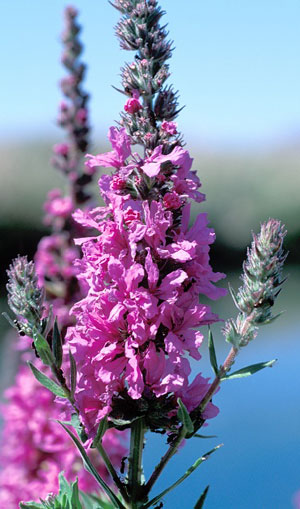Lythrum Salicaria
Purple Loosestrife
Synonym(s):
Family: Lythraceae
Duration and Habit: Perennial Herb

Photographer: Barry A. Rice & John M. Randall, The Nature Conservancy, Davis, CA
Source: http://www.nps.gov/plants/alien/fact/lysa1.htm
Description
Purple loosestrife (Lythrum Salicaria) is a perennial herb with bright magenta flowers of 5 to 7 petals during the majority of the summer months. Depending on environmental conditions, the herb can be 4 to 10 ft tall, and is always covered with a cotton or downy-like texture. Stems are square and woody with alternating leaves.
Ecological Threat: Federally endangered orchids and water fowl are greatly effected by purple loosestrife due to it's aggressive growing patterns and ability to out-compete native plants and reduce wildlife habitats. Purple loosestrife is able to grow and become established in a large variety of naturally disturbed areas and wetlands, putting a large number of native plant species at risk for local extinction from competition.
Biology & Spread: Purple loosestrife produces nectar to lure pollinating insects required for the plant to reproduce. Seed production is the primary method of dispersal once the plant has been pollinated. Flowers are present typically from June to September (depending on the local climate), allowing for a relatively long reproductive season. Individual plants are estimated to produce three million seeds per year. Purple loosestrife can also produce vegetatively at a rate of one foot per year of root growth. This form of vegetative reproduction allows for hybridization with other loosestrife plants including native plants from the genus Lythrum.
History: First introduced in the 1800's to the United States, purple loosestrife was intended for medicinal and ornamental uses. It has been used in many states to the present day as an ornamental plant with a handful of exceptions where sale and distribution is prohibited due the plant's invasive nature.
Habitat: Purple loosestrife can be found in wetlands, marshes, or disturbed areas with adequate standing water, such as road side ditches. It can also be found on the banks of ponds and meadows with standing water.
Distribution
Native Origin: Eurasia
U.S. Present: All states, with the exception of FL.
For a CAPS/CERIS/USDA map of past/present distribution, survey and eradication efforts click here.
Management
Small infestations of purple loosestrife can be managed in the early stages of detection by pulling any visible plants prior to seed dispersal. Herbicides such as Rodeo and Round-up have been proven effective in treating populations found in wetlands and uplands respectively. Application of herbicides is recommended in the late summer while plants prepare for winter dormancy. However, regular applications throughout the summer months may be effective in minimizing seed production and spread.
Text References
Heidorn, R., and B. Anderson. 1991. Vegetation management guideline: purple loosestrife (Lythrum salicaria L.) Natural Areas Journal 11: 172-173.
Internet Sources
http://pest.ceris.purdue.edu/map.php?code=PCYAEBB#
 Texas Invasive Species Institute
Texas Invasive Species Institute